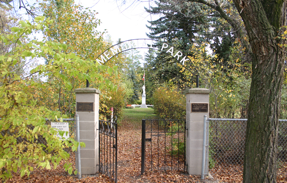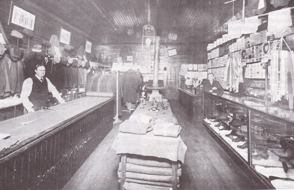Alfred Archer was born in Little Britain, Ontario. He
studied tailoring as an apprentice before he came west on a "harvest
train". After settling briefly in Hartney where he worked for Fry's as
a tailor he came to Reston.
Donnely's Gent's Furnishings was a store already established in Reston.
Mr Archer set up shop at the back of the store and
when Donnely sold out, Mr. Archer bought the business.
Mr. Archer was a professional. In 1910, he went to Chicago for further
training. He always took pride in his work but it was still secondary
to love for nature. His interest later changed to gardening and the
preservation or improvement of the environment as it is now called. He
understood the balance of nature and recognized the damages of using
pesticides and herbicides, a position which did not become popular or
accepted until after his death. He promoted the planting of trees and
flowers and especially encouraged tree planting for "shelter belts"
around farmlands and parks. In 1962, his work was recognized when he
received an Honorary Life Membership to the Manitoba Horticultural
Association.

Reston’s Memorial Park – where a plaque pays
tribute to Mr. Archer.
It is for his work on the grounds of the Reston Memorial Park that Mr.
Archer is most fondly remembered. He involved in the planning and
creation of the park. It was he who suggested that a park was the
appropriate place for such a memorial and selected the location, based
on suitability of the soil. He raised shrub and perennials in his own
back yard, as funds were scarce. He acted as park supervisor until he
left Reston in 1967.
Adapted from Trails Along the Pipestone, page
499, 528
The Small Town Tailor Shop
A former worker remembers the operation of Mr. Archer’s shop:
"A. Archer the Tailor" was once an advertisement familiar for miles
outside the Reston community. His advertisement in the Recorder;
“Archer's Tailored Clothes are Unequalled for Service", was the
absolute truth for no garment left his shop until the work was
perfect.
"Foremost in my memory is Mr. Archer's fairness, kindness, and good
humour. The shop was well lighted and comfortable, though steamy at
times from using the press which was just new then. One of the girls
helped him spot clothing brought in to be pressed. The really dirty
clothes were sent away to be dry cleaned, to Perth's, I think. This was
before the dry cleaning plant was installed.
When I was there, I think he employed six to eight girls. Miss Jessie
Affleck was head tailoress. She was a pretty ladylike spinster in her
forties. As apprentices, we got $24.00 a month. Every closing time, the
young ones had to sweep and dust under the strict supervision of Tina
and Miss Affleck. We worked from eight a.m. to six p.m. with an hour
off for lunch.
All of Mrs. Archer's lovely suits and dresses were made there and those
of many of the town ladies. Dr. Chapman had all of his shirts tailor
made. I remember the girls delighting in embroidering lazy daisies on
the shirt tails, I'm sure Mr. Archer knew about it but said nothing.
All buttonholes and buttons were sewn on by hand and only the
experienced girls did the button holes.
We were taught to overcast all seams by hand; this was called serging.
For the padding in the lapels of suits and overcoats, we had to join
two pieces of cloth together without a seam. This was called stealing.
We sat at counters with our feet on stools to do the hand work. The
counters were also used for laying out cut pieces and for Mr. Archer to
draft and cut his patterns. There was a counter down the west side and
one down the east side of the workroom. They were by the windows and
there was a long table down the middle which held the sewing machines.”
Adapted from Trails Along the Pipestone, page 499

Mr. Archer and his assistant in the shop
|





